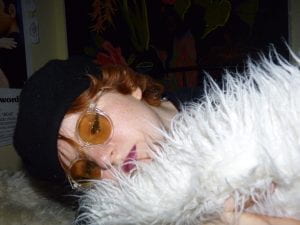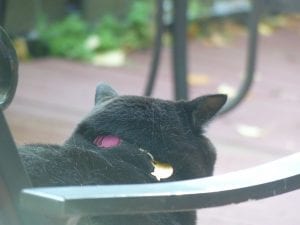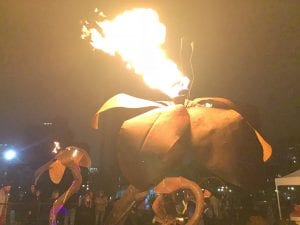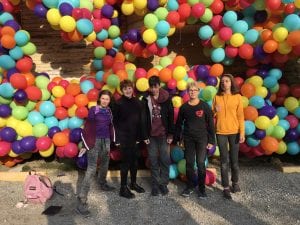Destination Imagination. How to I even begin?!
I guess we’ll open this like we always do…. welcome back to my blog! Another post, another cool learning milestone. This time, it’s perhaps the most awesome school project I’ve ever done! Recently, the PLP students in grades 8,9 and 10 participated in the 2019 Destination Imagination Regional tournament. Before you ask what Destination Imagination is, let me introduce you to it. This is my first experience with D.I., because I’ve just joined PLP this year, so I had no idea what it was either.
Destination Imagination is a tournament that happens around the world for the youngest schoolchildren to people in university. It’s an opportunity to enhance one’s skills in a variety of subjects (science, the arts, engineering, etc.), display multiple forms of deep thought and creativity, build working machines and sets, perform, and to get inspired by the creations of others just like yourself, working towards the same goals under the same standards. All of this is achieved by the completion of the challenges assigned every year by Destination Imagination. Each challenge is a different category; the available categories are Technical, Scientific, Engineering, Fine Arts, and Improvisational. These categories have different challenge criteria each year. Groups of kids will take on a challenge and try to complete its criteria, and then at Regionals, present the challenge criteria through a performance skit. Many schools participate in Destination Imagination, including the Seycove PLP kids in grades 8-10. For my Grade 9 class, we were put into groups, and then we chose our preferred challenge genres. My group members Aedan, Gabby, Izzy, Luciano and I chose the Improvisational genre, and we were ready to take on the Improvisational challenge.
The Improv challenge this year is called Heads Up. For this challenge, we had to choose 10 prolific Figureheads on famous coins from around the world and research them. Once we finished the thorough research of the Figureheads, we could begin to practice the skit.
As you can see, the requirements of the skit aren’t as easy to understand as one would suspect! Basically, we had to begin the skit with 2 minutes of preparation time, after being given our two Figureheads who are going to be the main characters of the skit, and a Tale, which is a short sentence to set up a story (example: “The Figureheads are working in the world’s smallest zoo.”). Once we are given the Tale and the Figureheads (both randomly selected), we also need to know whether or not the skit is beginning with Tragedy or Comedy. Once this is sorted we begin the 2 minute prep time to discuss a storyline, and how the Figureheads are going to be incorporated into this Tale. During this prep, we also have to decide what’s going to happen after the Flip. The Flip is a piece of paper that has an event that will impact the storyline and indicate the transition of Verbal to Nonverbal in the skit (for example, a Flip could be “Suddenly it begins to rain jellybeans.”). When one of the group members sees it fit during the skit, they will turn over the Flip, which is immediately incorporated into the story, and indicates the change into Nonverbal, which is pretty self-explanatory; we can no longer speak! After the prep time is over and we have hopefully established a vague outline of a story with a beginning, middle and end, we begin the 5 minute skit. The skit usually begins with the Figureheads doing whatever the Tale depicts (for example, if the Figureheads are Athena and Victor Hugo and the Tale is “the Figureheads are hosting a bake sale”, then we must begin the skit with Athena and Victor Hugo hosting a bake sale.). The other group members will act as extra characters or narrators. This also must be executed according to the set genre (tragedy or comedy). After a beginning has been established and a problem has come up in the improvised skit, one of the characters will turn over the Flip, and read it out loud. When the Flip has been read, the skit switches to nonverbal, and the genre changes to whatever it wasn’t before (if the beginning before the Flip was Comedy, then the Nonverbal section after the Flip becomes Tragedy.). The characters then must continue the story Nonverbally and in the opposite genre according to the Flip. If the Flip is “suddenly, there is a massive tornado,” the group members must try to act this out tragically or comedically without speaking. This is the most difficult part of the skit, because we can no longer talk. We also have to attempt to bring the story to conclusion without narration or dialogue. Again, all of this must be executed in under 5 minutes! Once we signify that the skit is over, the Appraisers (judges of the skit) will call us over and discuss what we were successful at and what we could improve on.
Now that you know how the challenge works, I can go over how it went at the Regional Tournament for my group. Our name was Common Cents (haha, get it), and we even made a big sign for our group. About a month before Destination Imagination Regionals, we began research for our characters. Originally some of our selected figureheads were different, but we changed them to better accommodate our performance abilities. To organize the research, we decided to divide it into two categories: one sheet for research about facts, and one for characterization and personality development of the character. We kept adding to these sheets while continuing to expand on the characterization of our figureheads, and figuring out how to portray them.
I also made information sheets about the genres of Comedy and Tragedy. Research of these genres helped us get an idea of how to form basic comedic and tragic storylines in a short amount of time. This is essential when we are performing on the spot and have to come up with a story in our two-minutes prep time; having the set requirements on how to structure a good tragic or comedic story is harder then it seems, especially with tragedy. It’s important to begin with a tragic event, so that everything following is a result of the tragedy, instead of building up to it, which only works when you have a story that is entirely tragic. In our case it’s different. If we are starting with tragedy the story must turn comedic, so we have to begin with a tragic event instead of closing the story with one, like Romeo and Juliet does.
After we finished our research, we could get into practicing our skits with the different figureheads. This went pretty well, and it definitely helped us practice the characterization further and get a feel for how things were going to go at Regionals. I do feel like we needed to rehearse a lot more, but we had enough to get by. It would have been better to practice more because we didn’t get a chance to go over ever single character, so we didn’t know exactly what we were doing with some characters, and mainly just hoped that those certain characters didn’t get chosen.
Of course Karma decided to take advantage of this, and at Regionals, one of our characters chosen was the Merlion. This character was very hard to research because there is little information about it, and pretty difficult to characterize. Another group member was supposed to play this character, but I jumped in and played it because I knew more about it. Unfortunately it wasn’t really enough to portray it as well as I would have liked, and the lack of research made it so much harder to incorporate facts and characterization into the performance, because we were worrying on what the heck to do with this character. Again, we should have done a lot more run-throughs before D.I. started, and then we would have been faced with playing this character in practice, so we could have developed characterization, and researched more facts. We also need to work on disciplining ourselves when we’re supposed to be practicing. A huge problem was that we didn’t practice enough! It was very difficult with some of the team members who weren’t willing to put in the effort to rehearse. This just upped the stress level for the other team members and I. Being my first D.I., I didn’t know what to expect, but I knew that practice makes perfect, and that’s what we were really lacking that could have helped us polish our performance off a lot nicer.
Now that Regionals are finished, we have a little bit of time to reflect and change anything before Provincials. As I said before, I’m ready to put in more practicing of the character, and we decided to change the Merlion character to Terry Fox, so we’re going to need to research and develop a character for him. We also need to make sure that every member of the group is familiar with their characters and is ready to perform on the spot. To reflect on the positive, we all worked hard to study the genres and build personas for our historical figures. We also made a sign for our group, which was pretty much the only thing that cost making something. When we got to rehearsal, we did pretty well sometimes, and I definitely saw the improvement in our performances when we decided on some set factors for our improvisation; we would always have a narrator, clapping twice meant the actors stopped talking and the narrator spoke, the narrator becomes part of the story in the nonverbal section, etc. Once we had established some sort of routine, the outcome was that our performances were consistently good. Overall, I am proud of what our group achieved this Destination Imagination, even after factoring in all the ups and downs. I am looking forward to improving on our Regionals performance in Provincials!












March 28, 2019 at 2:33 am
Pretty cool! Good luck at Provincials!
April 9, 2019 at 4:33 pm
Thanks so much!